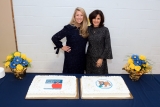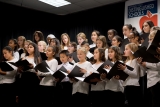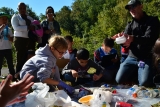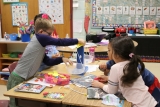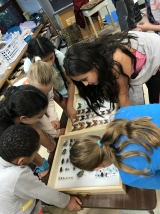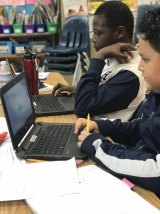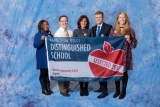-
Category 1
Selected in 2017
-
Grades: pre k - 5
School Setting: urban
Town Population: 1,140,000
Student Enrollment: 733
Student Demographics:
Black/African American: 14%
Teacher/Student Ratio: 1:20
White/Caucasian: 25%
Hispanic: 46%
Hawaiian/Pacific Islander: 0%
Asian: 10%
Native American: 0%
Other: 5%
% Reduced Lunch: 65%
% ELL Learners: 32%
Founded: 1954 -
PRINCIPAL:
Cecilia Vanderhye -
CONTACT:
6540 Columbia Pike
Falls Church, VA 22041
703-916-6800
cvanderhye@fcps.edu
Belvedere Elementary School
Falls Church, VA
Belvedere embraces a culture of learning for all, adults and students.
- Describe specific programs in place to ensure that families are involved in the success of your school and students.
- BES has a variety of programs, aided by a strong Parent-Teacher Association (PTA), Parent Liaison, and Parent Center, that support family engagement. These include literacy nights, mathematics and physical education night, science night with hands-on learning activities, after school enrichment activities, and Eco Discovery Night. The PTA sponsored International Night brings the community together to share food and traditions from the various cultures represented at the school. Belvedere has a robust Watch D.O.G.S. program that brings fathers into the school on a weekly basis. On average 60-70 school days per year include a father spending the day volunteering at school. Partners-in Print provides parents opportunities to engage alongside their child in literacy experiences that can be replicated at home. Family field trips to local destinations, such as the Smithsonian Air and Space Museum, offer a shared, positive learning experience for parents and children.
- Describe the most successful activity your school has initiated to strengthen ties to your community.
-
Two of the most successful activities at Belvedere are the Belvedere Outdoor Club and the afternoon Play Dates. Both of these activities have been teacher initiated. The Belvedere Outdoor Club is led by staff and invites families to spend one Saturday morning per month exploring a local park. The club helps families become familiar with a variety of local parks and helps all attending explore nature and inquire about plants and animals. Through the use of Title I funds, the school funds a bus to take families on these trips.
The Play Dates are new this year and are a way for staff to reach out to the community in a fun and relaxed manner. On school early-release days, staff meets students and parents at the outdoor areas of a local apartment complex that houses many school families and engages in outdoor games and fun at the playground. All school families are invited. - Describe your philosophy of school change or improvement.
- Creating a culture of learning with high collective efficacy is a priority. We believe school improvement is ongoing when staff see themselves as learners, feel empowered to problem solve and share their thinking, and understand that together they have what it takes to make a difference for every child at school. We also believe this is supported by a flattened organizational structure, where there is room for decision-making at different organizational levels and where the hierarchical structure is minimized unless absolutely necessary.
- What are your school’s top two goals for the next year?
-
Belvedere's top two goals are to continue strengthen and refine our school as a model IB-PYP public Title I school and to continue to hone instructional practices in language arts and mathematics across classrooms. To do this, our focus is on job-embedded professional development that includes learning sessions in and out of the classroom. Teachers have opportunities to engage in professional development in the areas of:
Digging deeper into Number Talks for composing/decomposing, addition and subtraction
Student led conference
Teaching reading in small groups
Word study problem solving group
Building mathematical argumentation
Inquiry circles in action
Writing about reading
Hands down class conversation
Making thinking visible
- What is the single most important factor in the success of your school that others could replicate?
- The single most important factor in the success of Belvedere is the collective power of the teams as they engage in the Professional Learning Community Process. As they write curriculum together, teams engage in deep discourse about student needs and instructional practices. Teams work together to identify strengths, weaknesses and strong plans for responding to where students are as learners and individuals. Teams engage in learning together so they have the knowledge and understanding to analyze the needs of students. Teams develop rich, authentic learning experiences to support common goals for students. The collective efficacy of the teams at Belvedere is powerful and effective in facilitating high levels of student achievement.
- Describe the program or initiative that has had the greatest positive effect on student achievement, including closing achievement or opportunity gaps, if applicable.
- The greatest contributing factor to BES’ success is the wholesale adoption that all students are unique individuals with diverse backgrounds capable of building their own knowledge to ultimately take action to make the world a better place. This belief is articulated and visible through the implementation of the International Baccalaureate Primary Years Program. The fundamentals of the IB-PYP embraced by the BES staff ensure equity of access to rich authentic learning experiences for all students. The BES staff is incredibly proud of the work around establishing and cultivating this philosophy developing rich and authentic learning experiences for all students with a laser-like focus on assessment data, using it to inform planning and execution of meaningful learning experiences. The work of establishing and maintaining this culture is challenging but in the end, it is what matters most to student achievement and development.
- Explain how Title I funds are used to support your improvement efforts.
- Title I funds are used to fund staff, professional development, instructional materials, and parent engagement opportunities. BES uses Title I funds to fund full day lab site professional learning designed by the reading and math specialists and the IB-PYP coordinator. Teachers explore and learn instructional strategies and then have the opportunity to plan and execute on the spot with students. These sessions include opportunities to debrief with their learning cohort for the day. Title I funds also pay for some resource staff salaries. These staff members work to build staff capacity by working directly with classroom teachers and students to support instructional planning and delivery. BES has an Outdoor Club led by teachers which aims to provide equitable access to local parks and nature reserves on a monthly basis. Title I grant funds support transportation to and from the school campus for families and children to explore local outdoor destinations to support learning.
- Identify the critical professional development activities you use to improve teaching and student learning.
- Through an ongoing series developed by administrators and district leaders, BES staff examines what makes each individual unique, what strategies and structures can be used to deepen understandings about colleagues and how all understandings and perspectives come together to strengthen collective efficacy and positively impact effectiveness as a school team. BES coaches offer full day lab site learning sessions that allow for learning to happen alongside teachers from other grade levels. Teachers explore and learn instructional strategies, plan and execute on the spot with students then reflect with colleagues. Professional development choices were determined by teacher feedback and interest. They include: Digging Deeper into Number Talks for Composing, Decomposing, Addition and Subtraction; Student Led Conferences; Teaching Reading in Small Groups; Word Study Problem Solving Groups; Building Mathematical Argumentation; Inquiry Circles in Action; and Writing About Readings.
- Describe how data is used to improve student achievement and inform decision making.
- A broad variety of data drives long-range and short-range plans at the school, team and classroom level. Data is instrumental in guiding daily teacher decisions that result in differentiated instructional support to meet individual student needs. BES teachers assess students regularly in reading, writing, and mathematics using common formative assessment data from reading and writing conferences, guided reading and guided mathematics, and performance-based tasks in mathematics. Teachers use authentic assessments with the most leverage for informing practice and cultivating problem solving. Each grade level team develops a viable curriculum through units of inquiry that integrate state and local curricula as the road map to educate students. BES staff structure units of inquiry around conceptual central ideas and develop formative and summative assessments to measure understandings of the central idea.
- Describe your school culture and explain changes you’ve taken to improve it.
- Belvedere embraces a culture of learning for all, adults and students. Ensuring that the school provides staff with rich job-embedded professional development, where adults engage in experiences that allow them to be students and learn together helps them foster a culture of learning for all as classroom teachers. Belvedere’s culture encourages students to be learners who are not afraid to take risks, who see failure as learning opportunities, and who embrace sharing their thinking with partners and groups. The single most important factor in developing this culture has been the adoption of the IB-Primary Years Program framework, where staff and students are encouraged to continually choose paths of inquiry, act on what they discover, and reflect on their learning.
Stats
-
Category 1
Selected in 2017
-
Grades: pre k - 5
School Setting: urban
Town Population: 1,140,000
Student Enrollment: 733
Student Demographics:
Black/African American: 14%
Teacher/Student Ratio: 1:20
White/Caucasian: 25%
Hispanic: 46%
Hawaiian/Pacific Islander: 0%
Asian: 10%
Native American: 0%
Other: 5%
% Reduced Lunch: 65%
% ELL Learners: 32%
Founded: 1954 -
PRINCIPAL:
Cecilia Vanderhye -
CONTACT:
6540 Columbia Pike
Falls Church, VA 22041
703-916-6800
cvanderhye@fcps.edu



